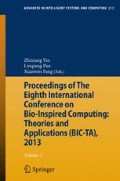Abstract
The maximal matching problem is a classic combinatorial optimization problem. Recently, computation by algorithmic tile self-assembly is proved to be a promising technique in nanotechnology, and this computational model is also demonstrated to be Turing universal. In this paper, the process of tile self-assembly model which is used to solve the maximal matching problem is shown including three operations: nondeterministic guess operation, AND operation and comparing operation. Our method can be performed this problem in Θ(mn) steps, here m and n is the number of edges and vertices of the given graph respectively.
Access this chapter
Tax calculation will be finalised at checkout
Purchases are for personal use only
References
Adleman LM (1994) Molecular computation of solutions to combinatorial problems. Science 266:1021–1024
Pan LQ, Liu GW, Xu J (2004) Solid phase based DNA solution of the coloring problem. Prog Nat Sci 14:104–107
Pan LQ, Pérez-Jiménez MJ (2010) Computational complexity of tissue-like P systems. J Complex 26:296–315
Seeman NC (1998) DNA nanotechnology: novel DNA constructions. Annu Rev Biophy Biomol Struct 27:225–248
Mao C, Sun W, Seeman NC (1999) Designed two dimensional DNA Holliday junction arrays visualized by atomic force microscopy. J Am Chem Soc 121:5437–5443
Barish R, Rothemund PW, Winfree E (2005) Two computational primitives for algorithmic self-assembly: copying and counting. Nano Lett 12:2586–2592
Lo PK, Metera KL, Sleiman HF (2010) Self-assembly of three-dimensional DNA nanostructures and potential biological applications. Curr Opin Chem Biol 14:597–607
Wang H (1961) Proving theorems by pattern recognition. I. Bell Syst Tech J 40:1–42
Winfree E (1998) Algorithmic self-assembly of DNA. Ph.D. thesis, Caltech, Pasadena, CA
Rothemund P, Winfree E (2000) The program-size complexity of self-assembled squares. In: Proceedings of the annual ACM symposium on theory of computing, Portland, USA, pp 459–468, May 21–23
Fujibayashi K, Murata S (2009) Precise simulation model for DNA tile self-assembly. IEEE T Nanotechnol 8:361–368
Brun Y, Reishus D (2009) Path finding in the tile assembly model. Theor Comput Sci 410:1461–1472
Reif JH, Sahu S, Yin P (2011) Complexity of graph self-assembly in accretive systems and self-destructible systems. Theor Comput Sci 412:1592–1605
Cardinal J, Labbe M, Langerman S et al (2005) A tight analysis of the maximal matching heuristic. Lect Notes Comput Sci 3595:701–709
Ding X, Yin ZX, Wang Y (2010) A DNA algorithm for maximal matching problem. International conference on bio-inspired computing: theories and applications, Beijing, China, pp 143–147
Acknowledgments
This work was supported by the National Natural Science Foundation of China (Grant Nos. 61202204, 60903105, 61202011).
Author information
Authors and Affiliations
Corresponding author
Editor information
Editors and Affiliations
Rights and permissions
Copyright information
© 2013 Springer-Verlag Berlin Heidelberg
About this paper
Cite this paper
Cheng, Z., Huang, Y., Xiao, J. (2013). Algorithmic Tile Self-Assembly for Solving the Maximal Matching Problem. In: Yin, Z., Pan, L., Fang, X. (eds) Proceedings of The Eighth International Conference on Bio-Inspired Computing: Theories and Applications (BIC-TA), 2013. Advances in Intelligent Systems and Computing, vol 212. Springer, Berlin, Heidelberg. https://doi.org/10.1007/978-3-642-37502-6_100
Download citation
DOI: https://doi.org/10.1007/978-3-642-37502-6_100
Published:
Publisher Name: Springer, Berlin, Heidelberg
Print ISBN: 978-3-642-37501-9
Online ISBN: 978-3-642-37502-6
eBook Packages: EngineeringEngineering (R0)

